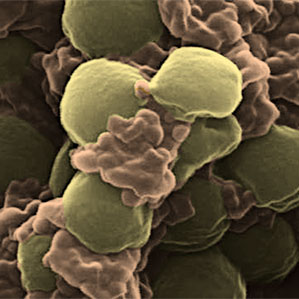Nanoparticles in Disguise Are a More Potent Antibiotic Treatment
Nanoparticles disguised as platelets, cells that circulate in the blood and form clots to stop bleeding from injured vessels, could serve as potent antibiotic treatments against certain hard-to-treat bacterial infections, according to new research.

Platelets also naturally adhere to certain invasive microörganisms. Aiming to take advantage of this, a group led by Liangfang Zhang, a professor of nanoengineering at the University of California, San Diego, has developed a way to wrap platelet membranes around tiny particles made of an FDA-approved biodegradable polymer. They’ve shown that the particles, when loaded with strong antibiotics, can target and treat drug-resistant Staphylococcus aureus (MRSA), a tough-to-kill and sometimes deadly bacterium that is a common source of infections in hospitals.
The researchers tested the treatment on mice with severe MRSA infections. They found that the new therapy was a more potent killer of the bacteria than doses that were six times larger of the same antibiotic without the nanoparticles. Since platelets also bind to areas where there is vascular damage, the technology could be used to treat conditions such as inflammation and maybe even cancer.
Other groups have made nanoscale drug vehicles inspired by platelets. But those systems have typically mimicked only one or two aspects of the chemistry on a platelet’s surface, and thus have had a difficult time evading the immune system’s defenses, says Zhang. Turning the surface of the particle into an actual platelet membrane gives it the power to evade the immune system and interact with cells and tissues without interfering with natural systems, he says. The system is also safe, says Zhang, since the outside is made of material that is already in the body, and the body can eventually break down the polymer core into carbon dioxide and water.
Zhang’s group has previously demonstrated nanoparticles, made via a similar process, that feature the same polymer cloaked instead in red blood cell membranes (see “Nanoparticle Disguised as a Blood Cell Fights Bacterial Infection”). Those particles act as decoys that can “soak up” toxins that many bacterial strains secrete, and remove them from the body. Zhang says it may be possible to combine the two particles to defeat bacteria in the bloodstream.
The new platelet-cloaked nanoparticle offers a glimpse into the future of nanomedicine, which will feature highly sophisticated systems—including more that combine synthetic materials with biological components, says Omid Farokhzad, an associate professor at Harvard Medical School and a physician-scientist at Brigham and Women’s Hospital’s department of anesthesiology. It will likely be a few years before the technology is ready for clinical testing.
Keep Reading
Most Popular
Large language models can do jaw-dropping things. But nobody knows exactly why.
And that's a problem. Figuring it out is one of the biggest scientific puzzles of our time and a crucial step towards controlling more powerful future models.
The problem with plug-in hybrids? Their drivers.
Plug-in hybrids are often sold as a transition to EVs, but new data from Europe shows we’re still underestimating the emissions they produce.
How scientists traced a mysterious covid case back to six toilets
When wastewater surveillance turns into a hunt for a single infected individual, the ethics get tricky.
Google DeepMind’s new generative model makes Super Mario–like games from scratch
Genie learns how to control games by watching hours and hours of video. It could help train next-gen robots too.
Stay connected
Get the latest updates from
MIT Technology Review
Discover special offers, top stories, upcoming events, and more.